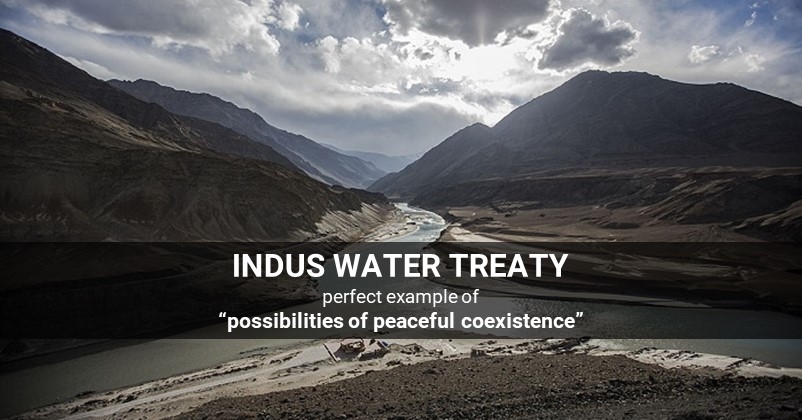Indus Water Treaty 1960: Pakistan Continues to Play Victim Card

September 19 marks the 60th anniversary of the Indus Water Treaty (IWT) between India and Pakistan. hailed as one of the finest, the most comprehensive international water treaties, remains a contentious issue even after 60 years.
This treaty addressed specific water allocation issues, providing unique design requirements for the run-of-the-river dams to ensure steady water flow and guarantee power generation through hydroelectricity, and also provides a mechanism for consultation and arbitration should questions, disagreements, or disputes arise between the incumbents.
The treaty is often cited as an example of the “possibilities of peaceful coexistence” that exist despite the troubled relationship. The World Bank, which, as the third party, played a pivotal role in crafting the IWT, continues to take particular pride that the treaty functions.
The 1960 treaty is perhaps the only agreement that physically divides the river system between two nations. But all does not seem well between the neighbours.
Following the development and construction of several projects by India on the western rivers, such as the Salal hydroelectric project, the Wullar barrage project, the Baglihar hydroelectric project, and the Kishanganga hydroelectric project to name a few since 1976, Pakistan has been accusing India of several violations of the treaty.
Over the past decade, Pakistan has been accusing India of diverting/storing water entitled to Pakistan on the western rivers. It is demanding a bigger share of water from rivers that run from India even though India, as per the treaty, generously gave away 80.52 per cent of the Indus system waters to Pakistan for indefinite duration.
The treaty allocates the water of the three western rivers to Pakistan, but allows India to tap the considerable hydropower potential before the rivers enter Pakistan. Second, the treaty allowed India to create storage on the western rivers of 1.25, 1.60, and 0.75 MAF (million acre feet) for general, power, and flood storages, respectively, amounting to total permissible storage of 3.6 MAF.
Third, the treaty does not require India to deliver assured quantities of water to Pakistan and instead it requires India to let flow to Pakistan the water available in these rivers excluding the limited use permitted to India by the treaty. Fourth, there are no quantitative limits to the hydroelectricity that India can produce using the western rivers nor any limit to the number of run-of-the-river projects India can build.
Equitable water-sharing
The sharing formula devised after prolonged negotiations sliced the Indus system into two halves. The three ‘western rivers’ (Indus, Jhelum and Chenab) went to Pakistan and the three ‘eastern rivers’ (Sutlej, Ravi and Beas) were portioned to India.
That the treaty has remained “uninterrupted” is because India respects its signatory and values trans-boundary rivers as an important connector in the region in terms of both diplomacy and economic prosperity. There have been several instances of terror attacks — Indian Parliament in 2001, Mumbai in 2008, and the incidents in Uri in 2016 and Pulwama in 2019 — which could have prompted India, within the Vienna Convention on the Law of Treaties, to withdraw from the IWT.
However, on each occasion, India chose not to do so. With abrogation an option that India is hesitant to take, there is a growing debate to modify the existing IWT. While the treaty may have served some purpose at the time it was signed, now with a new set of hydrological realities, advanced engineering methods in dam construction and de-siltation, there is an urgent need to look at it afresh.
Article XII of the IWT says that it “may from time to time be modified” but carefully notes “by a duly ratified treaty concluded for that purpose between the two governments”.
India has been woefully wanting in not utilising the 3.6 million acre feet (MAF) of “permissible storage capacity” granted by the IWT on the western rivers. Poor water development projects have allowed 2-3 MAF of water to easily flow into Pakistan which needs to be urgently utilised. Further, out of the total estimated capacity of 11406 MW electricity that can be harnessed from the three western rivers in Kashmir, only 3034 MW has been tapped so far.
What is the future of this treaty?
There is no clause to withdraw from the treaty. However, the existing geopolitical situation and the emerging China-Pakistan water axis prevent any workable negotiations with Pakistan. Both the Indus and Sutlej originate from China, which has been constructing storage/dams on these rivers before they enter the Indian territory.
The only workable option with India at present is to draw the maximum benefit from provisions of the treaty. This would involve utilising all available waters of the eastern rivers and exploiting full potential of the western rivers for irrigation and hydro-power.